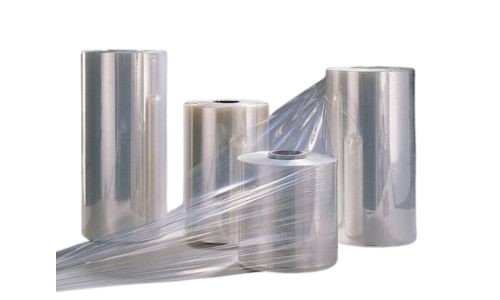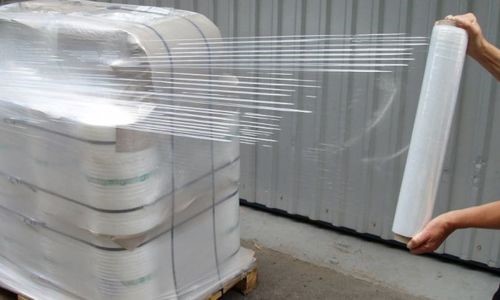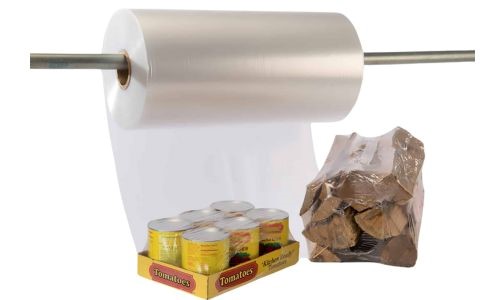When it comes to packaging, it may be a challenging process whether to choose shrink film wrapper or stretch film wrapping material.
A reason this guide compares all the vital aspects of stretch film and shrink film. Whether you want to learn about benefits, limitations, or applications – all information you need is right here.
What is a Shrink Film

This is a packaging solution designed from a polymer material that is incredibly versatile in its applications. These sheets are designed with varying sizes and thickness to better suit different applications. The film is activated using heat which causes it to shrink over a wrapped object tightly packing it
What is a Stretch Film
This protective film’s defining feature is its ability to stretch as it is wrapped around objects and is used to tightly secure different goods. The film is designed using low-density polyethylene which is what makes it stretch. When unwrapped from an object the film reverts to its original shape owing to its elasticity.

Advantages of Shrink Film vs Stretch Film
There are several advantages to each of these packaging solutions. It is therefore best for you to select one that has all the benefits you require. These benefits include:
Advantages of Shrink Film
- This packaging film has elevated levels of shrinkage that can mold onto packages with different and complex shapes.
- The material used is designed to resist punctures and tears ensuring that your package remains intact
- These films are incredibly versatile and are available in various strengths, clarities, thicknesses, and shrink ratios as well as come in distinct types.
- The ability of this protective film to shrink around an object gives a compressed seal which protects the product from potentially damaging elements. These elements include moisture, dirt, and dust among other contaminants.
- This protective cover is not only durable but can also resist high temperatures or conditions making it suitable for wrapping products that require shipping.
- It is also economically feasible as it is relatively cheaper to purchase and can be used for a wide range of applications.
Advantages of Stretch Film
- This type of protective film is easy to use and highly efficient as it does not require you to use adhesives or heat for it to adhere.
- It is a highly cost-effective method of packaging products as well as securing them for transportation.
- The film features an elevated coefficient of friction providing a firmer grip when you handle it and reducing the risk of the packaged goods moving around.
- The film is durable and keeps the products safe for extended periods maintaining the integrity as well as quality of the product.
- It also has an elasticity that allows it to revert to its original shape and can still effectively package a product.
- This film functions as a protective barrier keeping your products safe from harsh elements such as dust, dirt, moisture, other contaminants, and environmental factors.
- The versatile material can be used in various applications that involve packaging and securing products
Comparing Disadvantages of Shrink Film and Stretch Film
There are a few limitations that you may experience when using either one of these protective films. These limitations include
Disadvantages of Shrink Film
- Producing and distributing shrink requires a large amount of energy that hurts the environment.
- Although purchasing the shrink film is cheaper compared to other packaging materials, this method of packaging has several additional requirements that make it more expensive in the long run. Expenses such as primary packaging material and equipment to shrink wrap increase.
Disadvantages of Stretch Film
- These films are designed in various configurations and getting the wrong type may cause you losses in terms of wasted materials, time, and money. The wrong type of wrapping may also result in safety challenges.
- The elevated stretch of the material reduces friction which may make handling the material difficult
Types of Shrink FilmVs. Stretch Film
There are different categories of these packaging solutions. When selecting the most suitable film for you it is best to take into account the features of the different varieties available.
Types of Shrink Film
Shrink films are generally categorized according to their primary material. The types of films include;
- Polyvinyl Chloride; this type of shrink film has advantages such as enhanced durability, and strength.
- Polyolefin (POF): It features a more flexible and softer material ideal when you are packaging complex shapes.
- Polyethylene (PE): It is an industrial material that has quickly gained popularity thanks to being recyclable which makes it environmentally friendly.
Types of Stretch Film
There are various types of this film. You should therefore select one that fits into your operations. The different varieties include
- Hand Stretch Film: This is more suited for small-scale operations and relies on manual labor.
- Machine Stretch Film: The design relies on a machine and as such will require a wrapping machine to package products with. This variation is better suited for medium and large-scale operations.
- Pre-Stretch Film: This design requires stretching before packaging. This is an effective way of maximizing the film as it increases coverage while minimizing film
- Cast Stretch Film: Cast extrusion is the method of production used to design this variation.
- Reinforced Stretch Film: For a more durable and sturdy film this design is the most suitable one and is perfect for industrial application.
- Color Stretch Film: They come in various colors and you can select the most compatible color with your brand
- UVI Stretch Film: This design is treated to provide a protective layer against harmful ultraviolet rays
- VCI Stretch Film: It is treated to provide enhanced resistance to volatile corrosive materials
- Vented Stretch Film: Designed to be porous to allow free flow of air.
Applications of Shrink Film and Stretch Film

Both materials are incredibly versatile both in design and application. You can be used for both packaging products either as secondary or primary packaging materials. They are also used to secure products during transportation. Their various applications include
Applications of shrink film include packaging and securing;
- Food and beverages
- Non-food products
- Electrical and electronics
- Home appliances
- Toys
- Sporting goods.
Applications of stretch film include:
- Securing pallets
- Bundling products
- Product protection
- UV protection
- Concealing load contents
Conclusion
Both shrink and stretch film are cost-effective packaging and protective covers. They come in various designs with varying parameters. It therefore best to consider all the types of films as well as your intended application to get the
More Resources:
Shrink Wrapping Process – Source: JOCHAMP
Stretch Film Packaging Machine – Source: JOCHAMP
Shrink Wrap – Source: WIKIPEDIA
Stretch Wrap – Source: WIKIPEDIA


